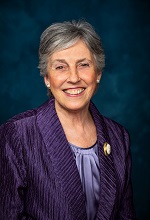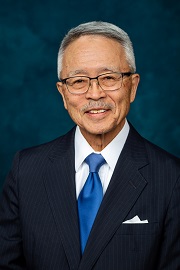
Where do we find inspiration? It so often feels elusive, like everyone else can find it, but not me. The truth is that inspiration is everywhere. The trick is to recognize it and then harness it so that one inspiration builds to the next and the next and the next, much like a ripple effect.
One way to find inspiration is to listen to others. Listening to what others are interested in shakes up our thinking and help us form new patterns.
Our R|L coaches share various talks that have recently inspired them. We hope that their messages create a ripple effect for you – stimulating growth in your thinking and actions to help you “Create Uncommon Results”®.
I hope that you enjoy viewing these talks as much as I have.

Clyde Lowstuter, MCC |
“How Your Brain Responds to Stories – and Why They’re Crucial for Leaders” by Karen Eber
As a lover of stories much like Karen, I was drawn to this TED Talk; throughout my life, I have seen that stories create the stickiness that shapes culture through an atmosphere of shared beliefs, values, common language, and operating tenets for engagement. Our brains “fully light up” when we connect with stories. In listening to stories, we empathize with the storyteller and during that time, trust is built between the audience and the speaker. Karen says, “Data doesn’t change our behavior, emotions do.” The powerful blend of audience engagement together with data-driven facts propels change. Karen reinforces that “it is not about finding a perfect story to tell, but telling your own story perfectly.” I hope you are inspired by her talk. Have fun experimenting this week and experiencing firsthand the power and impact your stories can have on your teams and organizations. |

Carolyn Lowstuter |
“How to Turn a Group of Strangers into a Team” by Amy Edmondson
In her TED Talk, Amy Edmondson discusses two critical elements of teaming: “situational humility” and “team synergies.” As executive leaders, we are hardwired to think we know the answers, however, it is hard to take risks with a team if you don’t show up willing to learn and suspend what you think you already know. At the intersection of knowledge and curiosity, psychological safety is created within the team. When teams shuffle—through mixing formal and informal teams—the groups are exposed to new vantage points and skills. Amy told the team to “look to the left and look to the right, and as fast as you can find the unique talents, skills, and hopes of each team member.” When we work with teams at R|L, we suggest that team members implant the strength characteristics of their team profile into their minds to be ready to call upon and activate the full scope of a team’s resources at any given moment. The challenges of today (and tomorrow) will require collaborative, team-oriented solutions that can only come from our willingness to “not know it all.” When we embrace different perspectives and different areas of expertise the team synergizes in a new and powerful way. Are you clear on your authentic strengths and how you are conveying those to others? Will your teammates know what they can count on from you as they look to their left and look to their right? |

Pat Mater |
“The Power of Introverts” by Susan Cain
It may sound like an oxymoron to juxtapose “Introverts” and “Power,” but I like the dichotomy of these two words. We live in a culture that celebrates extroversion and grapples with finding a way to interact with introverts. This isn’t about social skills – it is about where we get our energy. The reality is that one-third to one-half of people are introverts. Introverts get their stimulation from their internal thoughts and ideas – the place where creativity starts. Listen to this TED Talk to hear how you can look inside your suitcase to understand yourself better (you’ll have to listen to find out what that means). |

Kathryn Hartrick |
“How to Make Stress Your Friend” by Kelly McGonigal
In the TED Talk, Kelly McGonigal, a health psychologist, discusses the positive aspects of stress. She encourages enhancing our awareness of stress and shifting perspectives to be responsive and reflective on how stress can impact you positively. Her TED Talk also addresses the importance of building connections and community.
|

Kevin Price |
“Steve Jobs’s Stanford Commencement Speech” by Steve Jobs
This speech chronicles Steve Jobs’s major life experiences and lessons in three parts—connecting the dots, love and loss, and death. This speech is intriguing to me because it is about faith, hope, and courage. We all need to have faith that the actions we take today will connect with another point later in life. We all need to have hope that if we follow our passions any setbacks will lead us, eventually, to a satisfying future. We all need to have the courage to follow our chosen path. All our clients and colleagues need and can benefit from these lessons. “Your time is limited. Don’t waste it living someone else’s life.” Steve Jobs |

Pat Henahan, ACC |
“Radical Candor” by Kim Scott
Kim Scott’s concept of Radical Candor is wonderful in its simplicity. When we demonstrate that we care personally about an individual, we are free to challenge them directly without damaging the relationship. She contrasts radical candor with “ruinous empathy,” where show we care a lot, but don’t tell people what they need to know, and with “obnoxious aggression,” where we’re vocal in our opinion, but don’t show that we care. Obnoxious aggression triggers defensiveness. Ruinous empathy leaves the other party ignorant. In contrast, radical candor has the potential to stimulate growth. Many people are not skillful in sharing feedback. As a result, they may avoid providing it, or deliver it in a way that isn’t helpful. While there are many great feedback models out there, this video provides a foundational mindset for engaging with others. Kim Scott’s storytelling style and graphics are both memorable and entertaining.
|

Nora Bouchard |
“Why You Should Talk to Strangers” by Kio Stark
In her TED Talk, Kio speaks about the value of creating immediate and “fleeting intimacy” with strangers. Not only do we experience a sense of connection, but we also prove to ourselves the innate goodness of humanity. In that moment of eye contact and brief connection, we establish a “relationship” – a link between ourselves and one other person. As a coach, I meet a lot of strangers: possible clients, supervisors, colleagues, and friends. My job is to establish trust as quickly as possible so we can get to the heart of our work together. I use three of Kio’s principles in making this happen:
|

Ron Hirasawa |
“The Power of Vulnerability” by Brené Brown
Brené Brown’s motto for challenging situations is “fake it till you make it.” This sounds like one is insincere. However, it is the foundation of coaching and CBT (Cognitive Behavioral Therapy). We know that emotions drive behavior. CBT tells us that behavior also drives emotion. Don’t feel emotionally fit but feel vulnerable? Behave like you have confidence, and after a few successful attempts, you will feel better too – even if the new behavior is not perfect yet.
|
